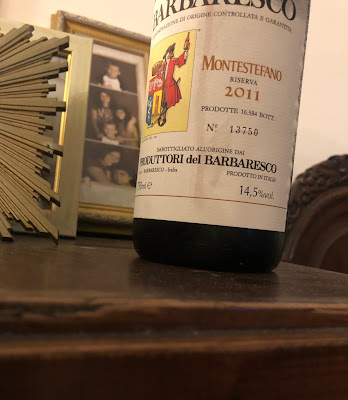35 euros. In Milan. Which answers the prime question, who the fuck is Milan?
Sometimes old school Barolos and Barbarescos have a whiff of old wood. Which is something distinct from new wood. New wood is the smell of a busy wood shop, which time and again has proven to overwhelm fruit. Old wood is that lovely scent that warms your heart when you open the drawer of your grandmother's antique bureau. Makes me think of Dickens and Balzac. I get that here, buried in deep and complex aromas of spices and dried flowers. The palate has the typical rusty, tannic texture and penetrating acidity of the best of the old school Nebbiolos, as well as the depth and complexity of a great vineyard. 2011 has been labeled as mediocre and it shows in the way the finish diffuses in the end. I love it, despite the lack of focus, because character does go a long way. (Apr. 9, 2019)
Domaine Pattes Loup, Chablis Premier Cru, Butteaux, 2014
A honeyed, cidery note threads beneath and across the minerals in the forefront of the nose, also coursing through the tangy acidity. Some on CellarTracker found it oxidative, some disappointing, I find it odd at first, an orange wine Chablis, then, as the oxidative notes recede, a rocky, marine character comes to bear and it shows a powerful, rough hewn character, Grand Cru in intensity if not complexity. (Apr. 1, 2019)
Bourgogne Crown, 215 NIS.
Scurek, Dugo, 2013
This Solvenian wine is one of the few orange wines I feel I'll ever need. A blend of 50% Ribolla Gialla, 30% Chardonnay, 20% Pinot Blanc from vines with an average age of 40 years., the nose is an offbeat marriage of sweet, cider-like notes and pungent minerals bordering on metal. The reason I like it is because it not only tells a story of a culture where this type of winemaking has a rich history, it's a fascinating wine in its own right (and no oxidative notes!). Close your eyes and focus on the aromas and flavors: the richness and character of the bouquet, the combination of sweet and umami flavors - they evoke a fine old Rioja Gran Reserva (you're welcome to choose your preferred color). (Apr. 5, 2019)
Saro Imports, 180 NIS.
R. López de Heredia, Rioja Reserva, Viña Tondonia, 2005
Seventeen times out of twenty, Heredia will give you a very memorable experience (out of the other three, one would be their weird rosé and two are bottle variations, since you'd likely drink them mature). This is one the memorable ones, a wine that develops and enriches over the course of three-four hours. The nose is nuanced and classic Rioja, red fruit with notes of cedar, balsamic vinegar, iron and worn leather. The palate balances its rich, warm fruit with excellent acidity and integrated, savory tannins. It doesn't lack in class or length - it'd outclass an average Gran Reserva (although not, of course, the Tondonia Gran Reserva, which is a class of its own). (Apr. 9, 2019)
Benoit Ente, Bourgogne-Aligoté, 2015
Proof that Burgundy is terroir first and grape second, because the nose is adorned by aromas of drying grass and flint that are what the Cote de Beaune is all about. The palate has a tangy, lively mix of soursweet acidity, ripe oranges and a pungent bite, which actually does come from the grape, Aligote. (Apr. 10, 2019)
Bourgogne Crown, 100 NIS.
Vitkin, Grenache Blanc, 2017
A funky, flinty nose with broad melon notes, followed by an austere, bitter, almost cerebral palate. I usually like this more. (Apr. 26, 2019)
Vitkin, Petite Sirah, 2013
This is very consistent, year in, year out, always showcasing black and blue fruit whose ripeness is balanced by juicy acidity and grainy tannins, graphite and iodine notes. I think there is greater potential elegance here than in previous vintages. (Apr. 27, 2019)
Quinta dos Carvalhais, Dão, Encruzado, 2017
White grapes are Portugal's secret weapon, so secret that no one has attempted to grown them abroad (as far as I know). Encruzado is the star of the Dao region. At its best, it displays focused exoticism generously tinted with minerals, structured as finely as a good Bourgogne. This isn't quite as fine or complex as the very best, but it's a good introduction. (Apr. 30, 2019)
17 euros.


Comments